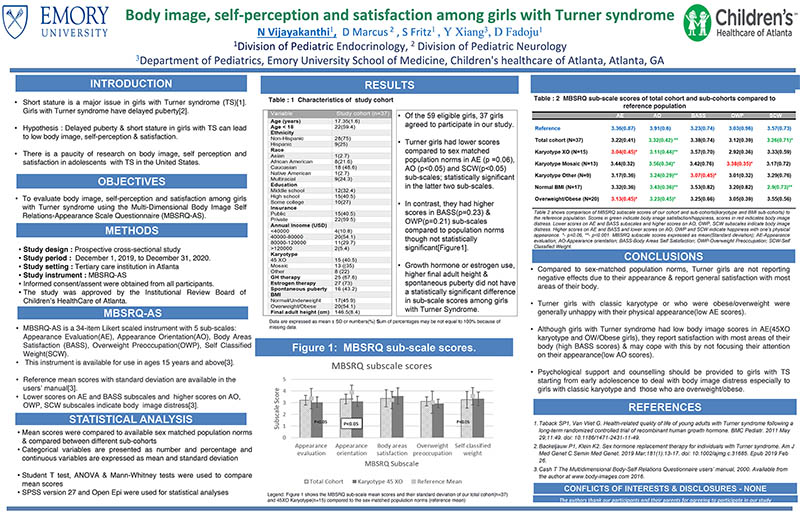
Hover to pan and click to magnify. Click again to pan at full screen.
Nandini Vijayakanthi MBBS DNB; David J Marcus PhD; Sobha P Fritz PhD; Yijin Xiang MPH; Doris Fadoju MD
Nandini Vijayakanthi MBBS DNB; David J Marcus PhD; Sobha P Fritz PhD; Yijin Xiang MPH; Doris Fadoju MD
Emory University School of Medicine, Children's Health Care of Atlanta
ABSTRACT
Objectives : Delayed puberty & short stature in girls with Turner syndrome can lead to low body image, self-esteem & satisfaction. We aimed to evaluate body image, self-perception and satisfaction among girls with Turner syndrome using Multi-Dimensional Body Image Self Relations-Appearance Scale Questionnaire(MBSRQ-AS). This prospective cross-sectional study was conducted at a tertiary care institution in Atlanta between December 1, 2019 to December 31, 2020.
Methods : Patients with karyotype proven diagnosis of Turner syndrome between ages of 15-21 years were included after they achieved final adult height. We used MBSRQ-AS which is a 34-item instrument with 5 sub-scales: Appearance Evaluation (AE), Appearance Orientation(AO), Body Areas Satisfaction (BAS), Overweight Preoccupation(OWP) and Self Classified Weight(SCW) sub-scales. Mean scores were compared to available sex matched population norms & compared between different sub-cohorts. T test, ANOVA & Mann-Whitney tests were used to compare mean scores using SPSS 27 and OpenEpi.
Results : Of the 59 eligible girls, 37 girls agreed to participate in our study with mean age: 17.35 ±1.6 years. Of these 37 girls, 15 had classic 45XO Karyotype. Turner girls had lower scores compared to sex matched population norms in AE(p =0.06), AO (p<0.05) and SCW(p<0.05) sub-scales; statistically significant in latter two sub-scales. In contrast, they had higher scores in BAS(p=0.23) & OWP(p=0.21) sub-scales compared to population norms though not statistically significant. Growth hormone or estrogen use, higher final adult height & spontaneous puberty did not have statistically significant difference in sub-scale scores. Girls with classic 45 XO karyotype, & girls who were overweight/obese had lower scores in AE & AO sub-scales compared to normal population(p<0.05).
Conclusion : Compared to sex-matched population norms, Turner girls are not reporting negative effects due to their appearance & report general satisfaction with most areas of their body; however Turner girls with classic karyotype or who were obese/overweight were generally unhappy with their physical appearance(low AE scores). Although girls with Turner syndrome had low body image scores in AE & AO sub-scales, they report satisfaction with most areas of their body (high BAS scores) & may cope with this by not focusing their attention on their appearance.

DISQUS COMMENTS WILL BE SHOWN ONLY WHEN YOUR SITE IS ONLINE